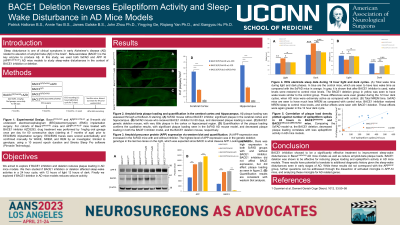BACE1 Deletion Reverses Epileptiform Activity and Sleep-Wake Disturbance in AD Mice Models
BACE1 Deletion Reverses Epileptiform Activity and Sleep-wake Disturbance in AD Mice Models
Friday, April 21, 2023


Patrick Halloran, BS
Medical Student
University of Connecticut
Farmington, Connecticut, United States
ePoster Presenter(s)
Introduction: Sleep disturbance is one of clinical symptoms in early Alzheimer’s disease (AD) related to elevation of amyloid beta (Aβ) in the brain. Beta-secretase (BACE1) is the key enzyme to produce Aβ. In this study, we used both 5xFAD and APP KI (APPNLGF/NLGF) AD mice models to study sleep-wake disturbances in the context of BACE1 inhibition or deletion.
Methods: Bace1fl/fl/5xFADand APPNLGF/NLGF at 9-month old underwent electroencephalogram (EEG)/electromyogram (EMG) implantation surgery. For cohorts of Bace1fl/fl/5xFAD mice and APPNLGF/NLGFmice treated with BACE1 inhibitor AZD3293, drug treatment was performed by 1mg/kg oral gavage once per day for 60 consecutive days (starting at 7 months of age) prior to EEG/EMG implantation surgery. EEG/EMG traces were scored automatically and confirmed manually for WAKE, NREM, and REM by an investigator, blinded to genotype, using a 10 second epoch duration and Sirenia Sleep Pro software (Pinnacle Technology).
Results: Sleep-wake pathologies of increased wakefulness and decreased NREM and REM sleep are evident in both 5xFAD and APP KI mice, but BACE1 inhibition in the adult reverses plaque load and sleep disturbances only in 5xFAD mice but not APP KI mice. Further mechanistic studies show that APP KI mice had more ill-contained, diffuse plaques and impaired plaque-associated microgliosis compared to 5xFAD mice, suggesting that the reversal of plaques and functional differences may be due to differences in microglial dysfunction of Aβ sequestration and clearance.
Conclusion : BACE1 inhibition showed to be a significantly effective treatment to improvement sleep-wake disturbances in Bace1fl/fl/5xFAD AD mice models as well as reduce amyloid-beta plaque loads. These results have potential to translate to additional diagnostic history given the sleep-wake disturbances seen in early stages of AD. While these results did not correspond with the APPNLGF group, further questions can be addressed through the dissection of activated microglia in APP-KI mice, and analyzing these microglia for AD related genes.
Methods: Bace1fl/fl/5xFADand APPNLGF/NLGF at 9-month old underwent electroencephalogram (EEG)/electromyogram (EMG) implantation surgery. For cohorts of Bace1fl/fl/5xFAD mice and APPNLGF/NLGFmice treated with BACE1 inhibitor AZD3293, drug treatment was performed by 1mg/kg oral gavage once per day for 60 consecutive days (starting at 7 months of age) prior to EEG/EMG implantation surgery. EEG/EMG traces were scored automatically and confirmed manually for WAKE, NREM, and REM by an investigator, blinded to genotype, using a 10 second epoch duration and Sirenia Sleep Pro software (Pinnacle Technology).
Results: Sleep-wake pathologies of increased wakefulness and decreased NREM and REM sleep are evident in both 5xFAD and APP KI mice, but BACE1 inhibition in the adult reverses plaque load and sleep disturbances only in 5xFAD mice but not APP KI mice. Further mechanistic studies show that APP KI mice had more ill-contained, diffuse plaques and impaired plaque-associated microgliosis compared to 5xFAD mice, suggesting that the reversal of plaques and functional differences may be due to differences in microglial dysfunction of Aβ sequestration and clearance.
Conclusion : BACE1 inhibition showed to be a significantly effective treatment to improvement sleep-wake disturbances in Bace1fl/fl/5xFAD AD mice models as well as reduce amyloid-beta plaque loads. These results have potential to translate to additional diagnostic history given the sleep-wake disturbances seen in early stages of AD. While these results did not correspond with the APPNLGF group, further questions can be addressed through the dissection of activated microglia in APP-KI mice, and analyzing these microglia for AD related genes.
